Related Research Articles

Shikoku, Japanese pronunciation:[ɕikokɯ] is the smallest of the four main islands of Japan. It is 225 km or 139.8 mi long and between 50 and 150 km or 31.1 and 93.2 mi wide. It has a population of 3.8 million. It is south of Honshu and northeast of Kyushu. Shikoku's ancient names include Iyo-no-futana-shima (伊予之二名島), Iyo-shima (伊予島), and Futana-shima (二名島), and its current name refers to the four former provinces that make up the island: Awa, Tosa, Sanuki, and Iyo.

Ehime Prefecture is a prefecture of Japan located on the island of Shikoku. Ehime Prefecture has a population of 1,334,841 and has a geographic area of 5,676 km2. Ehime Prefecture borders Kagawa Prefecture to the northeast, Tokushima Prefecture to the east, and Kōchi Prefecture to the southeast.
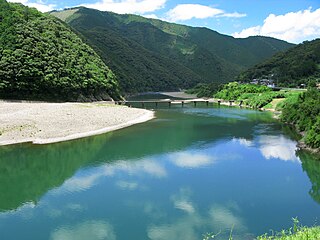
Kōchi Prefecture is a prefecture of Japan located on the island of Shikoku. Kōchi Prefecture has a population of 669,516 and has a geographic area of 7,103 km2. Kōchi Prefecture borders Ehime Prefecture to the northwest and Tokushima Prefecture to the northeast.

Tokushima Prefecture is a prefecture of Japan located on the island of Shikoku. Tokushima Prefecture has a population of 728,633 and has a geographic area of 4,146 km2. Tokushima Prefecture borders Kagawa Prefecture to the north, Ehime Prefecture to the west, and Kōchi Prefecture to the southwest.

Kagawa Prefecture is a prefecture of Japan located on the island of Shikoku. Kagawa Prefecture has a population of 949,358 and is the smallest prefecture by geographic area at 1,877 square kilometres (725 sq mi). Kagawa Prefecture borders Ehime Prefecture to the southwest and Tokushima Prefecture to the south.

Tosashimizu is a city located in the southwest of Kōchi Prefecture, Japan. As of 31 July 2022, the city had an estimated population of 12,407 in 7004 households, and a population density of 47 persons per km². The total area of the city is 266.34 square kilometres (102.83 sq mi).

Hiroshi Inagaki was a Japanese filmmaker who worked on over 100 films in a career spanning over five decades. He is one of the most successful and critically acclaimed filmmakers in the history of Japanese cinema, having directed several jidaigeki epics such as the 1954 Academy Award-winning film Samurai I: Musashi Miyamoto, and its two sequels.

Ōtoyo is a town located in Nagaoka District, Kōchi Prefecture, Japan. As of 1 August 2022, the town had an estimated population of 3277 in 1968 households and a population density of 10 persons per km². The total area of the town is 315.06 square kilometres (121.65 sq mi).
Ino is a town located in Agawa District, Kōchi Prefecture, Japan. As of 30 June 2022, the town had an estimated population of 21,672 in 10403 households and a population density of 46 persons per km². The total area of the town is 470.97 square kilometres (181.84 sq mi). The town is famous for the production of Japanese paper.
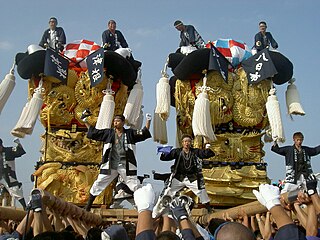
Shikokuchūō is a city located in Ehime Prefecture, Japan. As of August 31, 2022, the city had an estimated population of 83,635 in 28876 households and a population density of 200 persons per km². The total area of the city is 421.24 square kilometres (162.64 sq mi). Shikokuchūō is the leading producer of paper and paper products in Japan. It is also a port city and one of Ehime's major centers of industry.
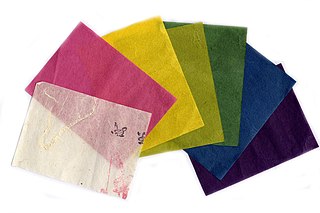
Washi (和紙) is traditional Japanese paper processed by hand using fibers from the inner bark of the gampi tree, the mitsumata shrub, or the paper mulberry (kōzo) bush.
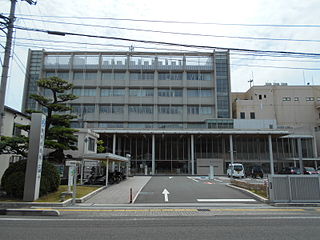
Seiyo is a city located in Ehime Prefecture, Japan. As of 31 August 2022, the city had an estimated population of 35,456 in 17627 households and a population density of 69 persons per km². The total area of the city is 514.34 square kilometres (198.59 sq mi).

Kumakōgen is a town in Kamiukena District, Ehime Prefecture, Japan. As of 1 September 2022, the town had an estimated population of 6,922 and a population density of 12 persons per km². The total area of the town is 583.69 square kilometres (225.36 sq mi).
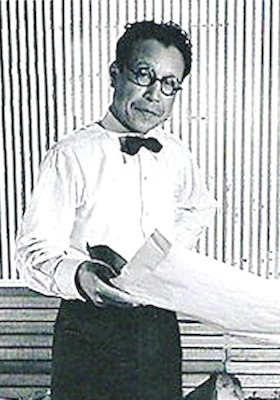
Isoya Yoshida was a Japanese architect. He graduated from Tokyo Art School in 1923. His style, known as sukiya, combines elements of traditional Japanese architecture and modernist architecture. Among his notable projects was the fourth iteration of the Kabuki-za, which was torn down in 2010 and replaced in 2013 by a new structure designed by Kengo Kuma. Yoshida was born and died in Tokyo.
Kuma or KUMA may refer to:
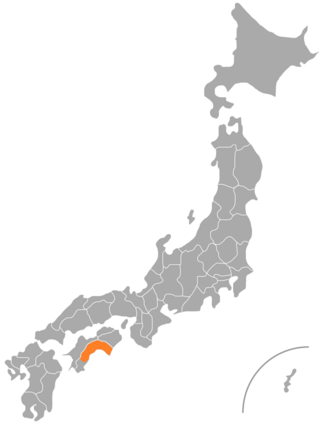
The Tosa dialect is a Japanese Shikoku dialect spoken in central and eastern Kochi Prefecture, including Kochi City. The dialect of the Western region of Kochi Prefecture is called the Hata dialect and is drastically different from the Central and Eastern dialect.
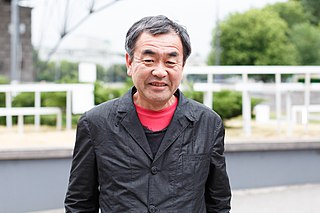
Kengo Kuma is a Japanese architect and emeritus professor in the Department of Architecture at the University of Tokyo. Frequently compared to contemporaries Shigeru Ban and Kazuyo Sejima, Kuma is also noted for his prolific writings. He is the designer of the Japan National Stadium in Tokyo, which was built for the 2020 Summer Olympics. He is married to architect Satoko Shinohara, and they have one son, Taichi, also an architect. He is an advisor for Kitakyushu-city in Japan.
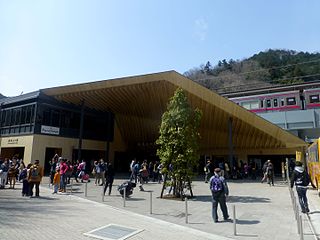
Takaosanguchi Stationis a passenger railway station located in the city of Hachiōji, Tokyo, Japan, operated by the private railway operator Keio Corporation. It is the main point of railway access to Mount Takao.

The Japan National Stadium, a.k.a the National Stadium and formerly known as New National Stadium or Olympic Stadium, is a multi-purpose stadium used mostly for association football in Kasumigaoka, Shinjuku, Tokyo, Japan. The facility served as the main stadium for the opening and closing ceremonies, as well as the venue for track and field athletics events at the 2020 Summer Olympics and 2020 Summer Paralympics in 2021.

Satoko Shinohara is a Japanese architect, architectural educator, and architectural researcher. She became the president of Japan Women's University in 2020. She presides over Spatial Design Studio and is a published author and editor. In a career that has addressed daily life, housing, and relationships, one of Shinohara's key design tenets is that housing is inherently a social space—one that can cultivate relationships among people, place, and the environment.
References
- 1 2 Mami Maruko (22 December 2012). "Dutchman keeps paper-making traditions alive at his Shikoku studio". The Japan Times. Retrieved 2021-06-29.
- ↑ "Under the Spell of Washi for Thirty-Five Years" (PDF). Tomodachi via japan.go.jp/. Government of Japan.
- ↑ KIKAN KOCHI / No.53: Think & Action Magazine, Kochi. Cricket Co., Ltd.
- ↑ "Future of Creation: Japanese paper craftsman Rogier Uitenboogaart x architect Kengo Kuma". Tokyo Art Beat.
- ↑ "Yusuhara Community Library / YURURI Yusuhara - 雲の上の図書館 / YURURIゆすはら". Kengo Kuma and Associates (in Japanese).
- ↑ Look Japan. Look Japan, Limited. 1997.
- ↑ "7 days in Shikoku Japan: top things to see and do". Rough Guides.
- ↑ Nagano, Tomonori (29 May 2021). "TV show on Japan: Japanology Plus (formerly known as "Begin Japanology")". Japan Studies at LaGuardia Community College.
- ↑ "[SERIES] MASTERS Enchanted by Washi". Cabinet Office, Government of Japan (June 2012).
- ↑ "OSAKA CHAKAI Recommend Rogier Uitenboogaart". OSAKA CHAKAI (2006).